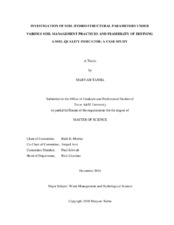| dc.description.abstract | Hydrostructural parameters are derived from continuously measured thermodynamic relationships which characterize the soil aggregates. The soil aggregate structure is unique and dynamic for each soil type and can be affected by the soil’s physical, chemical and biological properties. These parameters represent soil behavior and dynamically represent the changes in the soil aggregate structure with time. It can be used for developing a good quantitative indicator for the soil health. This study involves a field experiment to examine the changes in pedostructure-based soil characterization under different soil management methods and defining a new soil quality indicator. Three organic treatments (chicken, dairy manure and milorganite) were applied at 0, 168, 336, 672 kgN/ha (rate labeled 1, 2 and 3 respectively) for 36 plots with size 10 ft. × 5 ft. After extracting 12 hydro-structural parameters from TypoSoil measurements, statistical analysis evaluated the sensitivity of these parameters to changes in the soil management across the treatments. Results showed that increasing the rate of application from 1 to 3 didn’t show significant effects on hydrostructural parameters for any treatments. However, regardless of the type of treatment, management application significantly enhanced water content and available water in A horizon. In B horizon, only rate-3 affected available water for Chicken and Dairy manure. In the comparison between three treatments, the dairy manure has more obvious effects and is promising to improve soil aggregate structure for rates more than rate-1. Also, best application rate for chicken manure seems to be for treatment rate-1, for dairy manure, rate-2 and for milorganite rate3.
There are two reasons that developing a comprehensive soil quality indicator was not possible at this stage of the experiment. First, only sensitive parameters to different management (rate or treatment) were water content parameters but direct aggregate structure parameters didn’t change across treatments. Therefore, the soil quality indicator model with these parameters would not be all-inclusive. The short duration of the experiment (6 months) can explain the lack of change in the aggregate structure. However, adding the organic matter helped to increase the potential energy of holding the water and thus increased the water available capacity. Second, there are some other parameters such as crop yield and organic matter which could enhance small changes in aggregate structure parameters and make interpretations easier. These measurements and analysis are parts of research being conducted by Prairie View University researchers and results have not published yet. | en |


